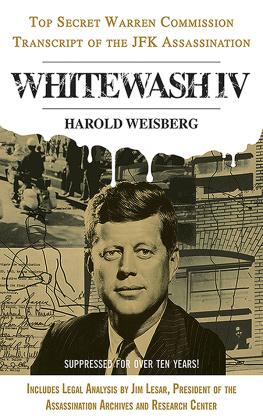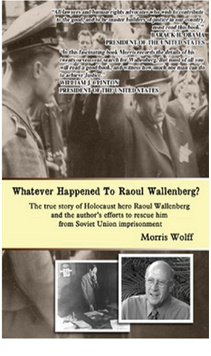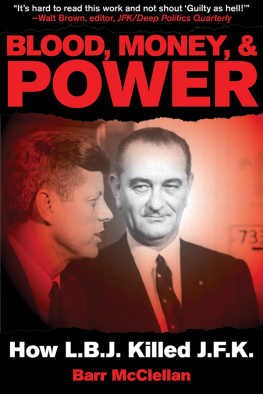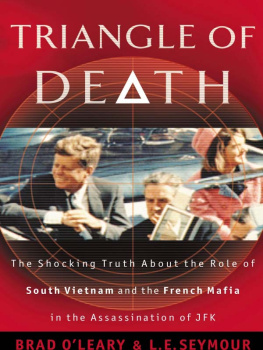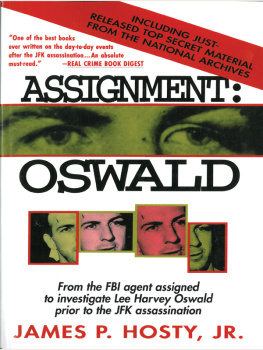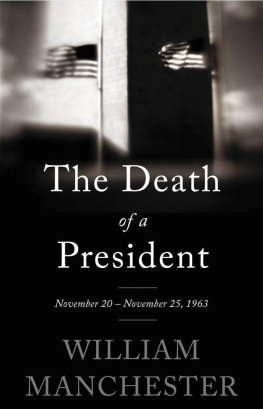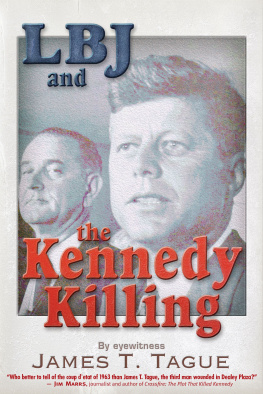
The author and publisher have provided this e-book to you for your personal use only. You may not make this e-book publicly available in any way. Copyright infringement is against the law. If you believe the copy of this e-book you are reading infringes on the authors copyright, please notify the publisher at: us.macmillanusa.com/piracy .
To the memory of my father,
Peter Warren Shenon,
whose kindheartedness and sense of fair play
were nurtured in the California
that Earl Warren created.
The assassination of John Fitzgerald Kennedy on November 22, 1963, was a cruel and shocking act of violence directed against a man, a family, a nation, and against all mankind. The final report of the Presidents Commission on the Assassination of President John F. Kennedy, September 24, 1964 QUESTION : Did he tell you anything about his trip to Mexico City? MARINA OSWALD : Yes, he told me that he had visited the two embassies, that he had received nothing, that the people who are there are too muchtoo bureaucratic. QUESTION : Did you ask him what he did the rest of the time? MRS. OSWALD : Yes, I think he said that he visited a bull fight, that he spent most of his time in museums, and that he did some sightseeing. QUESTION : Did he tell you about anyone that he met there? MRS. OSWALD : No. He said that he did not like the Mexican girls. Testimony of Marina Oswald to the Presidents Commission, February 3, 1964
Contents
Prologue
There is no way to know exactly when Charles William Thomas began to think about suicide. Who could really know such a thing? Years later, congressional investigators could offer only their strong suspicions about what had finally led Thomas, a former American diplomat who had spent most of his career in Africa and Latin America, to kill himself. On Monday, April 12, 1971, at about four p.m., he put a gun to his head on the second floor of his familys modest rented house, near the shores of the Potomac River, in Washington, DC. His wife, downstairs, thought at first that the boiler had exploded.
Certainly two years earlier, in the summer of 1969, Thomas had reason to be disheartened. He was forty-seven years old, with a wife and two young daughters to support, and he knew his career at the State Department was over. It was official, even though he still could not fathom why he was being forced out of a job that he loved and that he thoughtthat he knew he did well. The department long had an up or out policy for members of the diplomatic corps, similar to the military. Either you were promoted up the ranks or your career was over. And since he had been denied a promotion to another embassy abroad or to a supervisors desk in Washington, Thomas was selected out, to use the departments Orwellian terminology for being fired. After eighteen fulfilling, mostly happy years wandering the globe on behalf of his country, he was told he had no job.
At first, he thought it must be a mistake, his wife, Cynthia, said. His personnel records were exemplary, including a recent inspection report that described him as one of the most valuable officers in the State Department, whose promotion was long overdue. After he was formally selected out, however, there was no easy way to appeal the decision. And Thomas, a proud, often stoical man, found it demoralizing even to try. He had already begun boxing up his belongings in his office and wondering if, at his age, it would be possible to begin a new career.
He did have one piece of unfinished business with the department before he departed. And on July 25, 1969, he finished typing up a three-page memo, and a one-page cover letter, that he addressed to his ultimate boss at the department: William P. Rogers, President Nixons secretary of state. Colleagues might have told Thomas it was presumptuous for a midlevel diplomat to write directly to the secretary, but Thomas had reason to believe that going to Rogers was his only real hope of getting someones attention. Thomas was not trying to save his job; it was too late for that, he told his family. Instead, the memo was a final attempt to resolve what had beenapart from the puzzle of his dismissalthe biggest, most confounding mystery of his professional life. Rogers was new to the State Department, sworn in only six months earlier along with the rest of Nixons cabinet. Thomas hoped Rogers might be willing to second-guess the career diplomats at the department whofor nearly four yearshad ignored the remarkable story that Thomas kept trying to tell them.
At the top of every page of the memo, Thomas typedand underlinedthe word CONFIDENTIAL.
Dear Mr. Secretary, he began. In winding up my affairs at the Department of State, there is a pending matter which I believe merits your attention.
The memo had a title: Subject: Investigation of Lee Harvey Oswald in Mexico.
* * *
His tone was formal and polite, which was certainly in character for Charles William Thomas, who used his middle name in official correspondence to avoid confusion with another Charles W. Thomas who worked at the department. He wanted to be remembered as a diplomatto be diplomaticto the end. He knew his memo outlined potentially explosive national-security information, and he wanted to be careful not to be perceived as reckless. He had no interest in leaving the State Department with a reputation of being some sort of crazy conspiracy theorist. At the end of the 1960s, there were plenty of craven, headline-grabbing truth-seekers peddling conspiracies about President Kennedys assassination. Thomas did not want to be lumped in with them in the history booksor in the classified personnel archives of the State Department, for that matter. His memo contained no language suggesting the personal demons that would lead him to take his life two years later.
Secretary Rogers would have had easy access to the details of Thomass career, and they were impressive. Thomas was a self-made man, orphaned as a boy in Texas and raised in the home of an older sister in Fort Wayne, Indiana. He served as a navy fighter pilot in World War II, then enrolled at Northwestern University in Evanston, Illinois, where he earned both a bachelors and a law degree. Foreign languages came easily; he was fluent in French and Spanish and, over the years, developed a working knowledge of German, Italian, Portuguese, and Creole; the last had been valuable during a diplomatic posting in Haiti. After Northwestern, he studied in Europe and received a doctorate in international law at the University of Paris. In 1951, he joined the State Department and served initially in hardship posts in West Africa, where, despite several severe bouts of malaria, he was remembered for his good humor and enthusiasm. His friends said he was the diplomat from central castingsix feet tall, blond, preppy handsome, articulate, and charming. Early in his career, colleagues assumed he was destined to achieve the rank of ambassador, running his own embassy.
In 1964, Thomas was named a political officer in the United States embassy in Mexico, where he was posted for nearly three years. Mexico City was considered an especially important assignment in the 1960s since the city was a Cold War hot spotLatin Americas answer to Berlin or Vienna. There were big Cuban and Soviet embassies, the largest in Latin America for both Communist governments. And the activities of Cuban and Soviet diplomats, and the many spies posing as diplomats, could be closely monitored by the United States with the assistance of Mexicos normally cooperative police agencies. The CIA believed that the Russian embassy in Mexico was the KGBs base for wet operationsassassinations, in the CIAs jargonin the Western Hemisphere. (It would have been too risky for the KGB to run those operations out of the Russian embassy in Washington.) Mexico City had itself been the scene of Kremlin-ordered violence in the past. In 1940, Soviet leader Joseph Stalin dispatched assassins to Mexico City to kill his rival Leon Trotsky, who was living there in exile.
Next page

